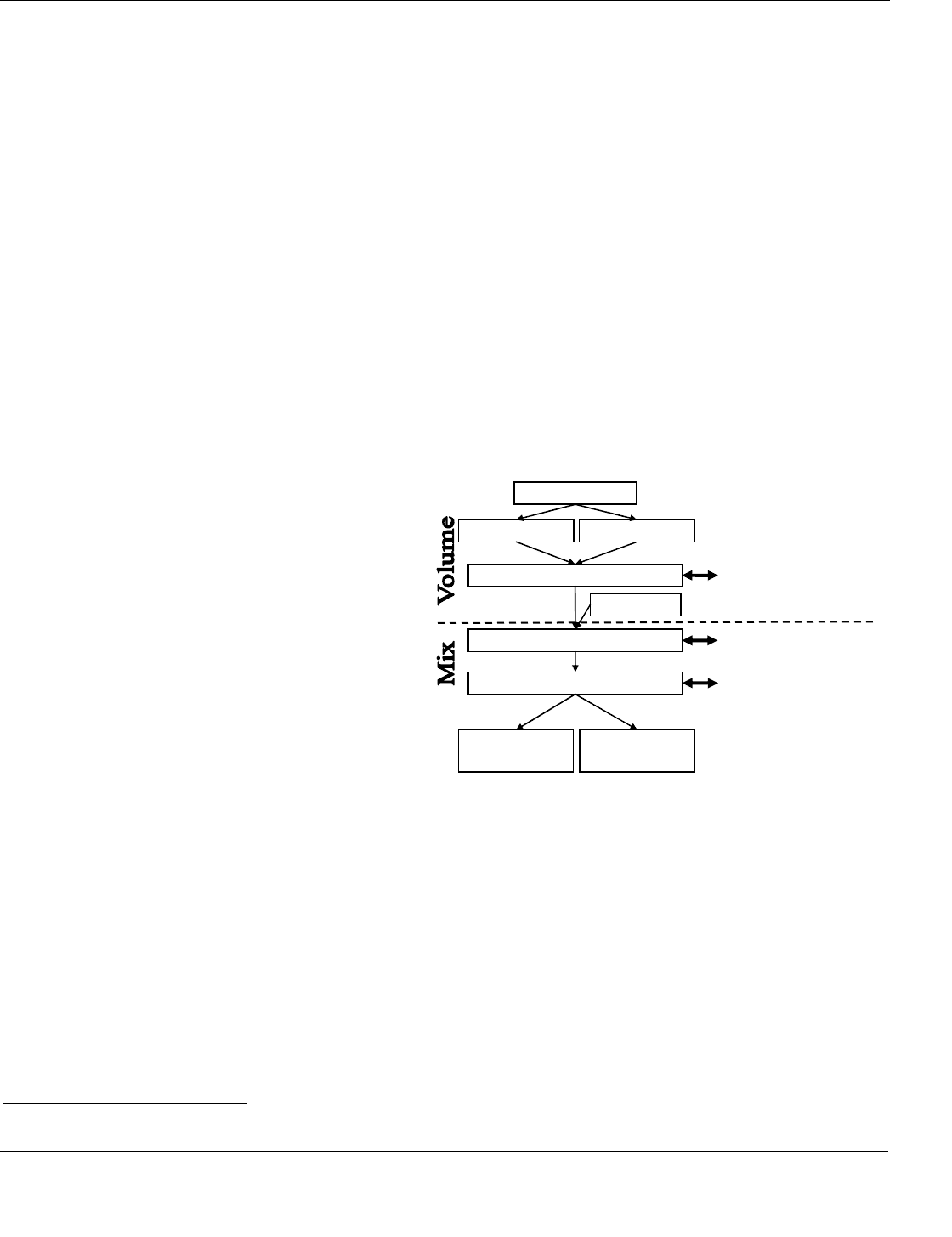Hill A.V. The Encyclopedia of Operations Management: A Field Manual and Glossary of Operations Management Terms and Concepts
Подождите немного. Документ загружается.


ptg6843605
Master Production Schedule (MPS) – Master Production Schedule (MPS)
The Encyclopedia of Operations Management Page 216
Eight strategies can be used for mass customization:
30
1. Design products for mass customization – Make the products customizable.
2. Use robust components – Commonality is a great way to improve customization.
3. Develop workers for mass customization – Mass customization and flexibility are fundamentally a function
of the flexibility and creativity of the workers.
4. Apply lean/quality concepts – Lean thinking (and short cycle times) and high quality are essential
prerequisites for mass customization.
5. Reduce setup times – Long setup times (and large lotsizes) are the enemy of mass customization.
6. Use appropriate automation – Many people equate mass customization with automation; however, many of
the best mass customization concepts have little to do with automation.
7. Break down functional silos – Functional silos contribute to long cycle times, poor coordination, and high
costs, all of which present obstacles to mass customization.
8. Manage the value chain for mass customization – Some of the best examples of mass customization use
virtual organizations and supply chain management tools to increase variety and reduce cost.
Pine and Gilmore (1999) have extended mass customization concepts to “experiences,” where the goal is to
create tailored memorable experiences for customers.
See agile manufacturing, assemble to order (ATO), commonality, configurator, economy of scope, engineer
to order (ETO), experience engineering, flexibility, functional silo, make to order (MTO), modular design
(modularity), operations strategy, pack to order, postponement, print on demand, product mix, product
proliferation, product-process matrix, push-pull boundary, respond to order (RTO), robust, sand cone model,
virtual organization.
Master Production Schedule (MPS) – A high-
level plan for a few key items used to determine
the materials plans for all end items; also known as
the master schedule.
As shown in the figure on the right, the
manufacturing planning process begins with the
strategic plan, which informs the business plan
(finance) and the demand plan (marketing and
sales), which in turn, inform the production plan
(manufacturing). The Sales & Operations
Planning Process (S&OP) then seeks to reconcile
these three plans. Resource Requirements
Planning (RRP) supports this reconciliation
process by evaluating the production plan to make
sure that sufficient resources (labor and machines) are available. RRP is a high-level evaluation process that only
considers aggregate volume by product families (often in sales dollars or an aggregate measure of capacity, such
as shop hours) and does not consider specific products, items, or resources.
Once the production plan is complete, the master scheduling process combines the production plan, firm
customer orders, and managerial insight to create the MPS, which is a schedule for end items. Rough Cut
Capacity Planning (RCCP) then evaluates the master schedule to make sure that sufficient capacity is available.
RCCP is more detailed than RRP, but only considers the small set of end items in the master production
schedule. Many firms consider major assemblies to be make to stock end items. The Final Assembly Schedule
(FAS) is then used to schedule specific customer orders that pull from this inventory. Although the MPS is
based on forecast (demand plan) information, it is a plan rather than a forecast, because it considers capacity
limitations. Even though the MPS has the word “schedule” in it, it should not be confused with a detailed
schedule.
Once the MPS is complete, the Materials Requirements Planning (MRP) process converts the MPS into a
materials plan, which defines quantities and dates for every production and purchase order for every item. MRP
30
Source: Professor Arthur V. Hill’s PowerPoint talk on Mass Customization.
Production Plan
Strategic Plan
Business Plan
Master Schedule (MPS)
Materials Plan
Manufacturing
Orders
MRP
Firm orders
Rough Cut Capacity
Planning (RCCP)
Capacity Requirements
Planning (CRP)
Purchase
Orders
Resource Requirements
Planning (RRP)
S&OP
Master
Schedulin
g
Demand Plan
Review &
release
Review &
release

ptg6843605
Master Production Schedule (MPS) − Master Production Schedule (MPS)
Page 217 The Encyclopedia of Operations Management
uses a gross-to-net process to subtract on-hand and on-order quantities and a back scheduling process to
account for planned leadtimes. Capacity Requirements Planning (CRP) then evaluates the materials plan to
make sure that sufficient capacity is available. CRP is more detailed than RCCP and considers the capacity
requirements for every operation in the routing for every production order in the materials plan. Although this
capacity check is more detailed than the others, it is still fairly rough, because it uses daily time buckets and uses
planned leadtimes based on average queue times. Advanced Planning and Scheduling (APS) systems can be
used to conduct even more detailed scheduling.
Once the materials plan is complete, planners and buyers (or buyer/planners) review the materials plan
and determine which manufacturing orders to release (send) to the factory and which purchase orders to release
to suppliers. The planners and buyers may also reschedule open orders (orders already in the factory or already
with suppliers) to change the due dates (pull in or push out) or the quantities (increase or decrease).
The planning above the MPS determines the overall volume and is often done in dollars or aggregate units
for product families. In contrast, the planning at the MPS level and below is done in date-quantity detail for
specific items and therefore determines the mix (Wallace & Stahl 2003).
Many firms do not have the information systems resources to conduct RRP, RCCP, and CRP.
All of the above plans (the production plan, master production schedule, and materials plan) have a
companion inventory plan. If the planned production exceeds the planned demand, planned inventory will
increase. Conversely, if planned production is less than the planned demand, planned inventory will decrease.
For example, the high-level production plan (aggregate plan, sales and operations plan) for a furniture
company specifies the total number of chairs it expects to need for each month over the next year. The MPS then
identifies the number of chairs of each type (by SKU) that are needed each week. MRP then builds a detailed
materials plan by day for all components and determines the raw materials needed to make the chairs specified
by the MPS.
The figure below shows three types of bill of materials. The assembly BOM starts with many components
(at the bottom of the BOM) and converts them into a few end products (at the top). The final product is a
standard product and typically has a make to stock customer interface. The modular BOM starts with many
components assembled into a few
modules (subassemblies) that are
mixed and matched to create many end
items. This is typically an assemble to
order customer interface. The
disassembly
31
BOM starts with a raw
material, such as oil, and converts it
into many end items, such as motor oil,
gasoline, and plastic. This is typically a make to order customer interface, but could also be make to stock.
The Theory of Constraints (TOC) literature labels the processes for making these three BOMs as the A-
plant, T-plant, and V-plant. See the VAT analysis entry for more detail.
The MPS is said to be “top management’s handle on the business,” because the MPS includes a very limited
number of items. Therefore, the MPS process should focus on the narrow part of the BOM, which suggests that
master scheduling should be done for end items for an assembly BOM, for major components for the modular
BOM, and for raw materials for a disassembly BOM. Safety stock should be positioned at the same level as the
MPS so that it is balanced between materials. In other words, a safety stock of zero units of item A and ten units
of item B is of little value to protect against demand uncertainty if the end item BOM requires one unit of each.
The Final Assembly Schedule (FAS) is a short-term schedule created in response to customer orders for the
modular BOM. The push-pull boundary is between the items in the master schedule and in the FAS.
See assemble to order (ATO), Available-to-Promise (ATP), back scheduling, bill of material (BOM), Bill of
Resources, Business Requirements Planning (BRP), Capacity Requirements Planning (CRP), chase strategy,
Final Assembly Schedule (FAS), firm order, firm planned order, level strategy, Materials Requirements Planning
(MRP), on-hand inventory, on-order inventory, production planning, push-pull boundary, Resource
31
The term “disassembly” was selected by this author. This term is not widely used in the literature.
Assembly BOM
(
Make to stock
)
Modular BOM
(
Assemble to order
)
Disassembly BOM
(
Cut or divide to order
)
MPS
FAS
MPS
FAS
MPS
FAS

ptg6843605
master schedule – Materials Requirements Planning (MRP)
The Encyclopedia of Operations Management Page 218
Requirements Planning (RRP), Rough Cut Capacity Planning (RCCP), safety leadtime, Sales & Operations
Planning (S&OP), time fence, VAT analysis.
master schedule – The result of the master production scheduling process.
See Master Production Schedule (MPS).
master scheduler – The person responsible for creating the master production schedule.
See Master Production Schedule (MPS).
material delivery routes – See water spider.
Material Review Board (MRB) – A standing committee that determines the disposition of items of questionable
quality.
materials handling – The receiving, unloading, moving, storing, and loading of goods, typically in a factory,
warehouse, distribution center, or outside work or storage area.
Materials handling systems use four main categories of mechanical equipment: storage and handling
equipment, engineered systems (e.g., conveyors, handling robots, AS/RS, AGV), industrial trucks (e.g., forklifts,
stock chasers), and bulk material handling (e.g., conveyor belts, stackers, elevators, hoppers, diverters).
See forklift truck, inventory management, logistics, materials management, receiving, supply chain
management.
materials management – The organizational unit and set of business practices that plans and controls the
acquisition, creation, positioning, and movement of inventory through a system; sometimes called materials
planning; nearly synonymous with logistics.
Materials management must balance the conflicting objectives of marketing and sales (e.g., have lots of
inventory, never lose a sale, maintain a high service level) and finance (e.g., keep inventories low, minimize
working capital, minimize carrying cost). Materials management often includes purchasing/procurement,
manufacturing planning and control, distribution, transportation, inventory management, and quality.
If a firm has both logistics and materials management functions, the logistics function will focus primarily on
transportation issues and the materials in warehouses and distribution centers and the materials management
function will focus on procurement and the materials inside plants.
See carrying cost, inventory management, logistics, materials handling, purchasing, service level, supply
chain management, Transportation Management System (TMS), warehouse, Warehouse Management System
(WMS).
materials plan – See Materials Requirements Planning (MRP).
Materials Requirements Planning (MRP) – A comprehensive computer-based planning system for both
factory and purchase orders; a major module within Enterprise Resources Planning Systems; also called
Manufacturing Resources Planning.
MRP is an important module within Enterprise Requirements Planning (ERP) systems for most
manufacturers. MRP was originally called Materials Requirements Planning and focused primarily on
planning purchase orders for outside suppliers. MRP was then expanded to handle manufacturing orders sent
to the shop floor, and some software vendors changed the name to Manufacturing Resources Planning.
MRP plans level by level down the bill of material (BOM). MRP begins by netting (subtracting) any on-
hand and on-order inventory from the gross requirements. It then schedules backward from the due date using
fixed planned leadtimes to determine order start dates. Lotsizing methods are then applied to determine
order quantities. Lotsizes are often defined in terms of the number of days of net requirements. With MRP
regeneration, a batch computer job updates all records in the database. With MRP net change generation, the
system updates only the incremental changes.
MRP creates planned orders for both manufactured and purchased materials. The set of planned orders
(that can be changed by MRP) and firm orders (that cannot be changed by MRP) is called the materials plan.
Each order is defined by an order number, a part number, an order quantity, a start date, and a due date. MRP
systems use the planned order start date to determine priorities for both shop orders and purchase orders. MRP is
called a priority planning system rather than a scheduling system, because it backschedules from due dates
using planned leadtimes that are calculated from the average queue times.

ptg6843605
matrix organization − Mean Absolute Deviation (MAD)
Page 219 The Encyclopedia of Operations Management
Nearly all MRP systems create detailed materials plans for an item using a Time Phased Order Point
(TPOP) and fixed planned leadtimes. Contrary to what some textbooks claim, MRP systems rarely consider
available capacity when creating a materials plan. Therefore, MRP systems are called infinite loading systems
rather than finite loading systems. However, MRP systems can use Rough Cut Capacity Planning (RCCP) to
check the Master Production Schedule (MPS) and Capacity Requirements Planning (CRP) to create load
reports to check materials plans. These capacity checks can help managers identify situations when the plant
load (planned hours) exceeds the capacity available. Advanced Planning and Scheduling (APS) systems are
capable of creating detailed materials plans that take into account available capacity; unfortunately, these systems
are hard to implement because of the need for accurate capacity, setup, and run time data.
See Advanced Planning and Scheduling (APS), allocated inventory, Available-to-Promise (ATP), bill of
material (BOM), Business Requirements Planning (BRP), Capacity Requirements Planning (CRP), closed-loop
MRP, dependent demand, Distribution Requirements Planning (DRP), effectivity date, Engineering Change
Order (ECO), Enterprise Resources Planning (ERP), finite scheduling, firm order, forecast consumption,
forward visibility, gross requirements, infinite loading, inventory management, kitting, low level code,
Manufacturing Execution System (MES), manufacturing order, Master Production Schedule (MPS), net
requirements, on-hand inventory, on-order inventory, pegging, phantom bill of material, planned order,
production planning, purchase order (PO), purchasing, routing, time bucket, time fence, Time Phased Order
Point (TPOP), where-used report.
matrix organization – An organizational structure where people from different units of an organization are
assigned to work together under someone who is not their boss.
In a matrix organization, people work for one or more leaders who are not their bosses and who do not have
primary input to their performance reviews. These people are “on loan” from their home departments. A matrix
organization is usually (but not always) a temporary structure that exists for a short period of time. An example
of a matrix organization is an architectural firm where people from each discipline (e.g., landscape architecture,
heating, and cooling) temporarily report to a project manager for a design project.
See performance management system, project management.
maximum inventory – See periodic review system.
maximum stocking level – An SAP term for the target inventory.
See periodic review system.
MBNQA – See Malcolm Baldrige National Quality Award.
MCE (Manufacturing Cycle Effectiveness) – See value added ratio.
mean – The average value; also known as the arithmetic average.
The mean is the arithmetic average of a set of values and is a measure of the central tendency. For a sample
of n values {x
1
, x
2
, … x
n
}, the sample mean is defined as
1
1
i n
i
i
x
x
n
. For the entire population of N values, the
population mean is the expected value and is defined as
1
1
i N
x
i
i
x
N
. Greek letter
is pronounced “mu.”
For a continuous distribution with density function ( )
f
x , the mean is the expected value
( ) ( )
x
x
E
X x f x dx
, which is also known as the complete expectation and the first moment. The
partial expectation, an important inventory theory concept, is defined as ( ) ( )
z
x
H z x f x dx
.
The median is considered to be a better measure of central tendency than the mean when the data is likely to
have outliners. The median is said to be an “error resistant” statistic.
See box plot, geometric mean, interpolated median, kurtosis, median, mode, partial expectation, skewness,
trim, trimmed mean.

ptg6843605
Mean Absolute Deviation (MAD) – Mean Absolute Percent Error (MAPE)
The Encyclopedia of Operations Management Page 220
Mean Absolute Deviation (MAD) – A measure of the dispersion (variability) of a random variable; defined as
the average absolute deviation from the mean.
The mathematical definition of the MAD for a random variable x
i
with mean
is
1
1
| |
n
i
i
x
n
. The
standard deviation for a normally distributed random variable is theoretically exactly equal to
/2
M
AD
(approximately 1.25MAD). This is true asymptotically
32
, but will rarely be true for any sample.
Brown (1967) implemented this approach widely at IBM, because early computers could not take square
roots. However, by 1970, Brown argued that “MAD is no longer appropriate to the real world of computers. It
never was the correct measure of dispersion” (Brown 1970, p. 148).
Other experts, such as Jacobs and Wagner (1989), argue that MAD is a still good approach, because absolute
errors are less sensitive to outliers than the squared errors used in the variance and standard deviation. The MAD
approach continues to be used in many major inventory management systems, including SAP.
In a forecasting context, the average error is often assumed to be zero (i.e., unbiased forecasts). In this
context,
1
(1 / )
T
t
t
M
AD T E
. The MAD can be smoothed at the end of each period with the updating equation
1
(1 )
t t t
SMAD E SMAD
. The smoothed MAD is sometimes called the smoothed absolute error or SAE.
See forecast bias, forecast error metrics, forecasting, Mean Absolute Percent Error (MAPE), mean squared
error (MSE), Median Absolute Percent Error (MdAPE), outlier, Relative Absolute Error (RAE), robust, standard
deviation, tracking signal, variance.
Mean Absolute Percent Deviation (MAPD) – See Mean Absolute Percent Error (MAPE).
Mean Absolute Percent Error (MAPE) – A commonly used (but flawed) measure of forecast accuracy that is
the average of the absolute percent errors for each period; also called the Mean Absolute Percent Deviation
(MAPD).
MAPE is defined mathematically as
1
1
T
t
t
t
MAPE
T
E
D
, where E
t
is the forecast error in period t, D
t
is the
actual demand (or sales) in period t, and T is the number of observed values. Many firms multiply by 100 to
rescale the MAPE as a percentage. Note that the MAPE is not the MAD divided by the average demand.
The MAPE has three significant problems. First, when the demand is small, the absolute percent error in a
period (APE
t
= |E
t
|/D
t
) can be quite large. For example, when the demand is 10 and the forecast is 100, the APE
t
for that period is 90/10 = 9 (or 900%). These very large values can have an undue influence on the MAPE.
Second, when the demand is zero in any period, the MAPE is undefined. Third, it is conceptually flawed. The
MAPE is the average ratio, when it should be the ratio of the averages. In the opinion of many experts, the Mean
Absolute Scaled Error (MASE) is a better metric than the MAPE because it avoids the above problems.
One way to try to fix the MAPE is to Winsorize (bound) the ratio in each period at 100%, which means that
the MAPE is defined in the range [0%, 100%]. See the Winsorizing entry for details. However, in this author’s
view, this “fix” only treats the symptoms of the problem.
The average MAPE can be misleading as an aggregate measure for a group of items with both low and high
demand. For example, imagine a firm with two items. One item is very important with high demand, high unit
cost, and low MAPE (e.g., 10%), and the other is a very unimportant item with low demand, low unit cost, and
high MAPE (e.g., 90%). When these two MAPE values are averaged, the overall MAPE is 50%. However, this
gives too much weight to the low-demand item and not enough to the important item. The weighted MAPE
avoids this problem. The weighted average MAPE is defined as
1 1
/
N N
i i i
i i
wMAPE w
, where w
i
is the
importance weight for item i of N items. The annual cost of goods sold is the best weight to use in this equation.
32
The difference between the sample standard deviation and
/2 1.25
times the sample MAD will approach zero as the
sample size goes to infinity.

ptg6843605
Mean Absolute Scaled Error (MASE) − mean squared error (MSE)
Page 221 The Encyclopedia of Operations Management
Like many time series forecasting statistics, the MAPE can be smoothed with the updating equation
1
/ (1 )
t t t t
SMAPE E D SMAPE
. Be sure to Winsorize the APE
t
when implementing this equation.
See demand filter, exponential smoothing, forecast bias, forecast error metrics, forecasting, Mean Absolute
Deviation (MAD), Mean Absolute Scaled Error (MASE), mean squared error (MSE), Median Absolute Percent
Error (MdAPE), Relative Absolute Error (RAE), Thiel’s U, tracking signal, Winsorizing.
Mean Absolute Scaled Error (MASE) – A forecast performance metric that is the ratio of the mean absolute
deviation for a forecast scaled by (divided by) the mean absolute deviation for a random walk forecast.
Hyndman and Koehler (2006) proposed the MASE as a way to avoid many of the problems with the Mean
Absolute Percent Error (MAPE) forecast performance metric. The MASE is the ratio of the mean absolute
error for the forecast and the mean absolute error for the random walk forecast. Whereas the MAPE is the
average of many ratios, the MASE is the ratio of two averages.
In the forecasting literature, the mean absolute error for the forecast error is called the Mean Absolute
Deviation (MAD) and is defined as
1
1
T
t t
t
M
AD D F
T
, where D
t
is the actual demand and F
t
is the forecast
for period t. The random walk forecast for period t is the actual demand in the previous period (i.e., F
t
= D
t–1
);
therefore, the Mean Absolute Deviation for the random walk is
1
1
1
T
RW t t
t
M
AD D D
T
. This assumes a one-
period-ahead forecast, but it can easily be modified for a k-period-ahead forecast. The MASE, therefore, is
defined as
/
RW
M
ASE MAD MAD
.
The MASE will only have a divide-by-zero problem when the demand does not change over the entire
horizon, but that is an unlikely situation. When MASE < 1, the forecasts are better than the random walk
forecast; when MASE > 1, the forecasts are worse than the random walk forecast. A forecasting model with a
MASE of 20% has a forecast error of 20% of the forecast error of the simplistic random walk forecast. A MASE
of 95% is only slightly better than a simplistic random walk forecast.
The Mean Absolute Scaled Accuracy (MASA) is the companion accuracy measure for the MASE and is
defined as 1 – MASE. MASA can be interpreted as the percent accuracy of the forecast relative to the accuracy of
the random walk forecast. When MASA = 0, the forecasts are no better than the random walk forecast; when
MASA < 0, the forecasts are worse than the random walk forecast; and when MASA = 60%, the average absolute
forecast error is 40% of the average absolute forecast error for the random walk forecast. MASE and MASA are
better measures of forecast accuracy than MAPE because they measure accuracy against an objective standard,
which is the random walk forecast.
Hyndman and Koehler (2006, p. 13) assert that measures based on scaled measures (such as the MASE)
“should become the standard approach in comparing forecast accuracy across series on different scales.”
However, the MASE has two organizational challenges. First, it is not always easy to explain to managers.
Second, when changing from MAPE to MASE, those responsible for forecasting will have to explain why the
reported forecast accuracy decreases dramatically.
Dan Strike at 3M has suggests a very similar metric that uses a 12-month moving average as the scaling
factor. This metric is even simpler than MASE to explain, but may be slightly harder to implement.
Thiel’s U
3
metric is the mean squared error scaled by the mean squared error for the random walk forecast.
Therefore, it can be argued that the “new” MASE scaling concept is just an adaption of Thiel’s metric that uses
the MAD rather than the mean squared error (MSE).
MASE can be implemented with simple moving averages or with exponential smoothing for both the
numerator (the smoothed MAD) and the denominator (the smoothed MAD for a random walk forecast).
See forecast error metrics, Mean Absolute Percent Error (MAPE), Relative Absolute Error (RAE).
mean squared error (MSE) – The expected value of the square of the difference between an estimator and the
parameter.
The MSE measures how far off an estimator is from what it is trying to estimate. In forecasting, the MSE is a
measure of the forecast error that is the average of the squared forecast errors and is defined mathematically as

ptg6843605
Mean Time Between Failure (MTBF)
–
median
The Encyclopedia of Operations Management Page 222
2
1
1
T
t
t
MSE
T
E
, where E
t
is the forecast error in period t and T is the number of observed values. The MSE is
an estimate of the variance of the forecast error and is approximately equal to the variance when the forecast bias
is close to zero. Like most time series statistics, the MSE can be smoothed with the updating equation
2
1
(1 )
t t t
SMSE SMSE E
. The
root mean squared error (RMSE)
is the square root of the MSE and is an
estimate of the standard deviation of the forecast error. In fact, the RMSE will be equal to the standard deviation
of the forecast error if the forecast is unbiased. Variances are additive, but standard deviations are not; therefore,
RMSE is not normally smoothed.
See forecast bias, forecast error metrics, Mean Absolute Deviation (MAD), Mean Absolute Percent Error
(MAPE), standard deviation, tracking signal, variance.
Mean Time Between Failure (MTBF) – A maintenance and reliability term for the average time that a
component is expected to work without failing.
The MTBF is a good measure of
product reliability
. The MTBF is often modeled with the
bathtub curve
that has higher failure rates at the beginning and end of the product life cycle. The
Mean Time For Failure
(MTFF)
is the average time to the first failure and is sometimes used for non-repairable products.
See availability, bathtub curve, maintenance, Mean Time to Repair (MTTR), New Product Development
(NPD), reliability, Total Productive Maintenance (TPM).
Mean Time to Repair (MTTR) – A maintenance and reliability term for the average time required to fix
something, such as a machine.
The MTTR is a measure of the complexity and cost of a repair job and a measure of the
maintainability
of a
product (Schroeder 2007). The MTTR should not be used as the only performance measure for service techs
because the best service techs are often assigned the most difficult repair jobs, which means they will have the
highest MTTR. The same is true for doctors and other skilled professionals.
See availability, maintenance, Mean Time Between Failure (MTBF), New Product Development (NPD),
serviceability, Total Productive Maintenance (TPM).
Measurement System Analysis (MSA) – An approach for verifying the accuracy and precision of a data
measurement system using statistical analysis tools, such as Gauge R&R, attribute Gauge R&R, and the P/T
ratio.
See Gauge, Gauge R&R, metrology.
MECE – The concept that an analysis should define issues and alternatives that are mutually exclusive and
collectively exhaustive; pronounced “me-see.”
MECE thinking is widely used by strategy consulting firms, such as McKinsey, Bain, and BCG, to create
both issue trees and decision trees (Rasiel 1998). In fact, the case interview method these firms use to screen
applicants is designed to test MECE thinking.
Mutually exclusive
means that the ideas or alternatives are distinct and separate and do not overlap.
Collectively exhaustive
means that the ideas or alternatives cover all possibilities. The Venn diagram below
shows two sets (A and B) that overlap and therefore are not mutually exclusive. The union of sets A, B, and C is
collectively exhaustive because it covers all possibilities.
In most anlysies, it is far more important that issues be separable
than MECE. For example, an outgoing shipment could be late because
of mechanical problems with a truck or because the products were not
ready to ship. These two events are not mutually exclusive, because
they both could be true, but they can and should be studied separately.
See causal map, decision tree, issue tree, Minto Pyramid Principle,
story board, Y-tree.
median – The middle value of a set of sorted values.
The median, like the mean, is a measure of the
central tendency
. The calculation of the median begins by
sorting the values in a list. If the number of values is odd, the median is the middle value in the sorted list. If the
A B
C

ptg6843605
Median Absolute Percent Error (MdAPE) − milestone
Page 223 The Encyclopedia of Operations Management
number of values is even, the median is the average of the two middle values in the sorted list. For example, the
median of {1, 2, 3 , 9, 100} is 3, and the median of {1, 2, 3, 9 , 100, 200} is (3 + 9)/2 = 6.
The median is often a better measure of central tendency than the mean when the data is highly skewed. For
example, consider the following selling prices for houses (in thousands): $175, $180, $200, $240, $241, $260,
$800, and $2400. The mean is $562, but the median is only $240.5. In this case, the mean is “pulled up” by the
two high prices.
Excel provides the function MEDIAN(range) for computing the median of a range of values.
Some people consider the interpolated median to be better than the median when many values are at the
median and the data has a very limited number of possible values. For example, the interpolated median is often
used for Likert survey questions on the 1-5 or 1-7 scale and also for grades in the U.S. that are translated from A,
A-, B+, etc. to a 4.0 scale.
See box plot, forecast error metrics, interpolated median, mean, Median Absolute Percent Error (MdAPE),
mode, skewness, trimmed mean.
Median Absolute Percent Error (MdAPE) – The middle value of all the percentage errors for a data set when
the absolute values of the errors (negative signs are ignored) are ordered by size.
See forecast error metrics, Mean Absolute Deviation (MAD), Mean Absolute Percent Error (MAPE),
median.
mergers and acquisitions (M&A) – The activity of one firm evaluating, buying, selling, or combining with
another firm.
Whereas an acquisition is the purchase of one company by another, a merger is the combination of two
companies to form a new company. In an acquisition, one firm will buy another to gain market share, create
greater efficiency through economies of scale, or acquire new technologies or resources.
The goal for both mergers and acquisitions is to create shareholder value. The success of a merger or
acquisition depends on whether this synergy is achieved from (1) growing revenues through synergies between
products, markets, or product technologies or (2) economies of scale through headcount reduction, purchasing
leverage, IT systems, HR, and other functional synergies. Unfortunately, planned synergies are not always
realized, and in some cases revenues decline, morale sags, costs increase, and share prices drop.
See acquisition, antitrust laws, economy of scale.
Metcalfe's Law – See network effect.
Methods Time Measurement (MTM) – See work measurement.
metrology – The science of measurement; closely related to Measurement System Analysis (MSA).
Metrology attempts to validate data obtained from test equipment and considers precision, accuracy,
traceability, and reliability. Metrology, therefore, requires an analysis of the uncertainty of individual
measurements to validate instrument accuracy. The dissemination of traceability to consumers (both internal and
external) is often performed by a dedicated calibration laboratory with a recognized quality system.
Metrology has been an important topic in commerce since people started measuring length, time, and weight.
For example, according to New Unger’s Bible Dictionary, the cubit was an important measure of length among
the Hebrews (Exodus 25:10) and other ancient peoples. It was commonly measured as the length of the arm
from the point of the elbow to the end of the middle finger, which is roughly 18 inches (45.72 cm).
The scientific revolution required a rational system of units and made it possible to apply science to
measurement. Thus, metrology became a driver of the Industrial Revolution and was a critical precursor to
systems of mass production. Modern metrology has roots in the French Revolution and is based on the concept
of establishing units of measurement based on constants of nature, thus making measurement units widely
available. For example, the meter is based on the dimensions of the Earth, and the kilogram is based on the mass
of a cubic meter of water. The Système International d’Unités (International System of Units or SI) has gained
worldwide acceptance as the standard for modern measurement. SI is maintained under the auspices of the Metre
Convention and its institutions, the General Conference on Weights and Measures (CGPM), its executive branch,
the International Committee for Weights and Measures (CIPM), and its technical institution, the International
Bureau of Weights and Measures (BIPM). The U.S. agencies with this responsibility are the National Institute of
Standards and Technology (NIST) and the American National Standards Institute (ANSI).
See gauge, Gauge R&R, lean sigma, Measurement System Analysis (MSA), reliability.

ptg6843605
milestone – mindmap
The Encyclopedia of Operations Management Page 224
milestone – An important event in the timeline for a project, person, or organization.
A milestone event marks the completion of a major deliverable or the start of a new phase for a project.
Therefore, milestones are good times to monitor progress with meetings or more formal “stage-gate” reviews that
require key stakeholders to decide if the project should be allowed to continue to the next stage. In project
scheduling, milestones are activities with zero duration.
See deliverables, project management, stage-gate process, stakeholder.
milk run – A vehicle route to pick up materials from multiple suppliers or to deliver supplies to multiple customers.
The traditional purchasing approach is for customers to send large orders to suppliers on an infrequent basis
and for suppliers to ship orders to the customer via a common carrier. With a milk run, the customer sends its
own truck to pick up small quantities from many local suppliers on a regular and frequent basis (e.g., once per
week). Milk runs speed delivery and reduce inventory for the customer and level the load for the supplier, but at
the expense of additional transactions for both parties. Milk runs are common in the automotive industry and are
a commonly used lean practice. Hill and Vollmann (1986) developed an optimization model for milk runs.
See lean thinking, logistics, Vehicle Scheduling Problem (VSP).
min/max inventory system – See min-max inventory system.
mindmap – A diagram used to show the relationships between concepts, ideas, and words that are connected to a
central concept or idea at one or more levels.
A mindmap is a graphical tool that can be used by an individual or a group to capture, refine, and share
information about the relationships between concepts, ideas, words, tasks, or objects that are connected to a
central concept or idea at one or more levels in a hierarchy. Mindmaps can be used to:
Generate ideas
Capture ideas
Take course notes
Provide structure to ideas
Review and study ideas
Visualize and clarify relationships
Help plan meetings and projects
Organize ideas for papers
Create the storyboard for a presentation
Stimulate creativity
Create a shared understanding
Create the agenda for a meeting
Communicate ideas with others
Teach concepts to others
Document ideas
Help make decisions
Create a work breakdown structure
Create a task list
Prioritize activities
Solve problems
A mindmap represents how one or more people think about a subject. The spatial organization on the paper
(or screen) communicates the relationship between the nodes (ideas, concepts, objects, etc.) in the creator’s mind.
Creating a mindmap helps the creators translate their thinking about a subject into more concrete ideas, which
helps them clarify their own thinking and develop a shared understanding of the concepts. Once created, a
mindmap is an excellent way to communicate concepts and relationships to others.
Methods – The concepts on a mindmap are drawn around the central idea. Subordinate concepts are then
drawn as branches from those concepts. Buzan and Buzan (1996) recommend that the mindmaps should be
drawn by hand using multiple colors, drawings, and photos. This makes the mindmap easier to remember, more
personal, and more fun. They argue further that the mindmap should fit on one piece of paper, but allowed it to
be a large piece of paper. Many powerful software packages are now available to create mindmaps, including
Mind Manager (www.mindjet.com), Inspiration (www.inspiration.com), and many others.
Relationship to other mapping tools – A mindmap is similar to a causal map, except the links in a
mindmap usually imply similarity rather than causality. A strategy map is a special type of causal map. A
project network shows the time relationships between the nodes and therefore is not a mindmap. A bill of
material (BOM) drawing and a work breakdown structure are similar to mindmaps in that they show relatedness
and subordinated concepts.
Mindmap example – The example below was created by the author with Mindjet Mind Manager software to
brainstorm both the work breakdown structure and the issue tree for a productivity improvement project. The
symbol (+) indicates that additional nodes are currently hidden from view.

ptg6843605
Minkowski distance metric
−
minor setup cost
Page 225 The Encyclopedia of Operations Management
In conclusion, mindmaps are a
powerful tool for visualizing, structuring,
and communicating concepts related to a
central idea. This author predicts that
mindmapping software will become as
popular as Microsoft’s process mapping
tool (Microsoft Visio) and project
management tool (Microsoft Project
Manager).
See causal map, issue tree, process
map, project network, strategy map, Work
Breakdown Structure (WBS).
Minkowski distance metric – A
generalized distance metric that can be
used in logistics/transportation analysis,
cluster analysis, and other graphical
analysis tools.
If location i has coordinates (x
i
, y
i
), the
Euclidean (straight-line) distance between
points i and j is
2 2
( ) ( )
ij i j i j
d x x y y
, which is
based on the
Pythagorean Theorem
. The
Manhattan square distance
only
considers travel along the x-axis and y-axis
and is given by
| | | |
ij i j i j
d x x y y
. The Minkowski distance generalizes these metrics and defines the
distance as
1/
(| | | | )
r r r
ij i j i j
d x x y y
. The Minkowski distance metric is equal to the Euclidean distance
when r = 2 and the Manhattan square distance when r = 1. Minkowski distance can be defined in multi-
dimensional space. Consider item i with K attributes (dimensions) (i.e., x
i1
, x
i2
, … , x
iK
). The Minkowski
distance between items i and j is then defined as
1/
1
| |
r
K
r
ij ik jk
k
d x x
.
The
Chebyshev distance
(also called the maximum metric and the L
∞
metric) sets the distance to the longest
dimension (i.e.,
max(
| |,| |)
ij
i j i j
d
x x y y
and is equivalent to the Minkowski distance when r = ∞.
See cluster analysis, Manhattan square distance, Pythagorean Theorem.
min-max inventory system – An inventory control system that signals the need for a replenishment order to bring
the inventory position up to the maximum inventory level (target inventory level) when the inventory position
falls below the reorder point (the “min” or minimum level); known as the (s,S) system in the academic literature,
labeled (R,T) in this book.
As with all
reorder point systems
, the reorder point can be determined using statistical analysis of the
demand during leadtime distribution
or with less mathematical methods. As with all
order-up-to systems
,
the order quantity is the order-up-to level minus the current
inventory position
, which is defined as (on-hand +
on-order – allocated – backorders).
A special case of a min-max system is the (S − 1, S) system, where orders are placed on a “one-for-one”
basis. Every time one unit is consumed, another unit is ordered. This policy is most practical for low-demand
items (e.g., service parts), high-value items (e.g., medical devices), or long leadtime items (e.g., aircraft engines).
See inventory management, order-up-to level, periodic review system, reorder point.
minor setup cost – See major setup cost, setup cost.
